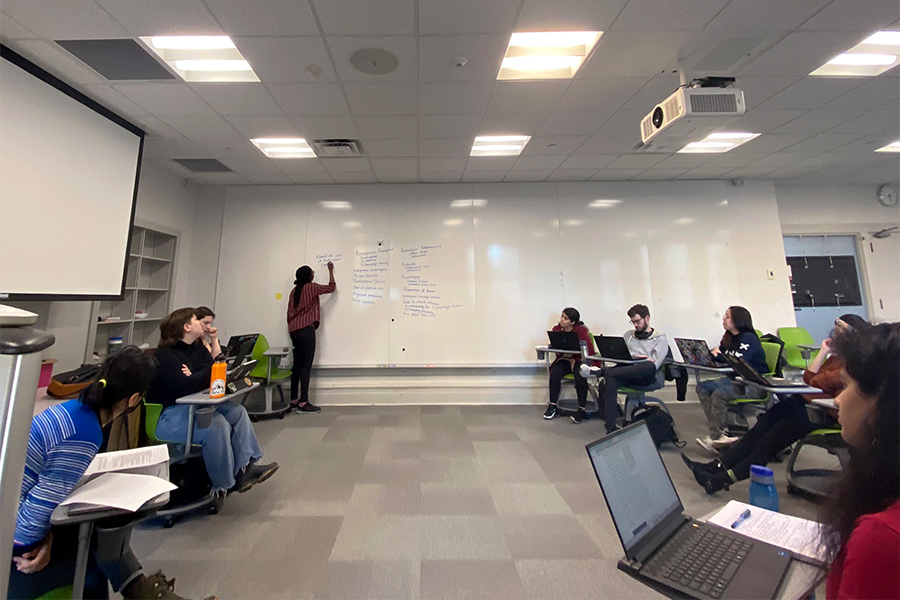Course Examines Environmental Injustice in Architecture
By Kathy Zhang
Being taught for the second time this past fall 2022 was Nida Rehman’s course, 48-699 Environmental Racism, Injustice, & Unfreedom: Lessons for Architecture. The mini is a discussion-based course which encourages students to “critically assess architecture’s role as a mechanism of environmental inequities and injustices, and learn from social movements for radical and hopeful change.” Students read about the history, present, and future of environmental injustice, and dig deep throughout the course to uncover how structural and systemic powers fueled and continue the pattern of devaluation, injustice. The course pulls from “a range of fields including Environmental Justice, urban political ecology, critical race studies, Black geography, indigenous studies.”
Nida Rehman, Assistant Professor for the School of Architecture at Carnegie Mellon University and a Steinbrenner Institute Advisory Board member, began teaching the mini in fall 2021. Rehman is an urban geographer and architect interested in the politics, processes, and aesthetics of urban environments. Her work brings in frameworks from urban history, geography, and the environmental humanities to question how our built environment reflects, perpetuates, shapes, and reshapes systemic injustices.
Morgan Newman, an architecture PhD student at CMU, took the course when it was first offered in 2021. At the time she was a master’s student studying public policy. Newman was drawn to the course’s subject matter and had already been focusing on architecture and design as her concentration within public policy. The course helped Newman grow her interests and emphasized to her that environmental racism is much more than what most people typically assume. “There are so many ways we can talk about environmental racism and how it has impacted Black and Indigenous communities around the country.” Newman felt that it was eye opening to see the broader patterns of environmental injustice and the systems which fuel it and vice versa, especially through the variety of academic readings, journal articles, documentaries the class explored.
What stuck with her most though is a project the class examined about Death Alley, also known as Cancer Alley, Louisiana, called Environmental Racism in Death Alley, Louisiana. Death Alley refers to an 85 mile stretch along the Mississippi River where the petrochemical industry has set up shop, leaving the majority-Black residents in the area with pollution that has caused high rates of cancer and a variety of respiratory and other health issues.
The project Newman is referring to is a project of Forensic Architecture, a research agency based at Goldsmiths, University of London that employs “architectural techniques and technologies to investigate cases of state violence and violations of human rights around the world.” She was drawn in not only by the subject of the research project but also by the research methods. Forensic Architecture utilized various methods, like 3D modeling, fluid dynamics (used to “trace the movement of particles through space”), and cartographic regression (“the process of overlaying historical surveys, maps, and aerial photographs onto contemporary aerial imagery to track the transformation of the land over time”) in an interdisciplinary, nontraditional way.
Newman was fascinated by this and realized that this was the type of research she wanted to conduct. The course ultimately led her to her current PhD endeavors and working with Rehman as her advisor. Newman’s research looks at rural southern communities in America and spatial dynamics in how communities have been affected by environmental racism. She credits Rehman and her course as the major influences for her work now. The course opened her eyes to what architecture encompasses and how the ways in which it can affect people and either contribute or fight environmental racism.
Environmental Racism, Injustice, & Unfreedom: Lessons for Architecture will next be offered fall 2023 and will be co-taught by Newman and Rehman. Newman plans on expanding the course through the topics and case studies it covers and diving deeper into sub-topics as well. She is also interested in regionalizing the course so that it focuses on environmental racism in Pittsburgh. This would allow students to begin identifying ways environmental injustice affects their neighbors and themselves, and to see first hand what environmental racism can look like. Seeing as the course is still young, Newman is excited to see how it will grow and to teach the course with Rehman.
